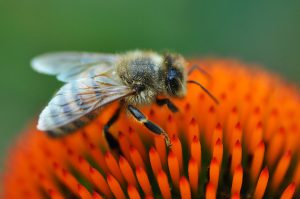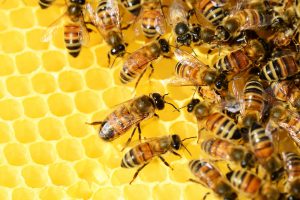New Study Shows Bee Populations Have Decreased Due to Multiple Factors
- NPG
- November 2, 2020
- NPG Commentary
- 1 Comment
November 03, 2020
Study of Bee Population Outlines How Farmers Can Protect Bees

Scientists in the U.S. and abroad have been aware, for some time now, that bees are in trouble. A recent study found that the combined threat of multiple stressors has endangered wild bee populations. Bees play an important role in the pollination of “…flowering trees and wildflowers, which in turn provide food and homes for other animals and improve water, air, and soil quality. Along with honey bees, wild bees are also vital for crop pollination. Research has shown that the presence of wild bees increases yields across many types of crops.” The survival of wild bees is paramount to future wild plant life and crops.
Researcher and lead author of the study Clara Stuligross of the University of California, Davis, notes: “Just like humans, bees don’t face one single stress or threat. Understanding how multiple stressors interplay is really important, especially for bee populations in agricultural systems, where wild bees are commonly exposed to pesticides and food can be scarce.” Along with the acknowledgment that there are multiple factors at play, the study highlights pesticide exposure as the factor with the greatest impact “on nesting activity and the number of offspring the bees produced…The research found that pesticide-exposed and resource-deprived female bees delayed the onset of nesting by 3.6 days and spent five fewer days nesting than unexposed bees.” Reduced nesting can be detrimental to future bee populations.
Stuligross explains the importance of a fertilized bee egg, stating: “When under stress from pesticides and limited food resources, the bees…appeared to intentionally produce fewer females. In bee biology, an unfertilized egg will become a male, and a fertilized egg will become female.” The bees in this study chose to fertilize fewer eggs and unfortunately, “Fewer females mean less crop pollination – and less reproduction.”
Researchers have outlined several ways farmers can protect bees:
- Plant wildflowers in areas without pesticides

- Use pesticides after bloom, when the exposure risk is lower for bees
- Consider using alternative pesticides
Peter Graystock, a research fellow in London, believes the best solution is already at our fingertips, saying: “It’s important to appreciate the vast diversity of our pollinator communities, not just in the terms of bee diversity but also floral diversity. Frequently in ecology, we find the solutions for maintaining the health of our wildlife are simply to support and promote our native wild communities above others.”
NPG understands the important role bees play in both nature and agriculture. Without bees, sustainable wild spaces and crops will not recover. That is why NPG works every day to share the message that we must work together to achieve a smaller, truly sustainable, population to allow our natural resources to flourish once again.
To read more about species extinction and other population topics, please see the NPG Forum paper series, particularly:
The UN Species Extinction Report: Is it Science, or Something Else? By Edwin S. Rubenstein
Crushing Biodiversity with the Weight of the Human Race By Leon Kolankiewicz
MAKE A GENEROUS CONTRIBUTION TODAY!
| [WD_Button id=18412] |

MIKE STRADA
Excellent article! Aloha, Mike